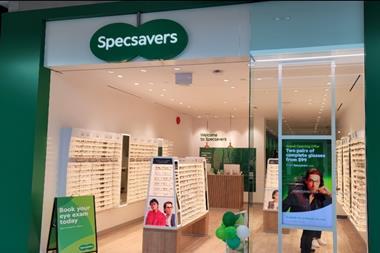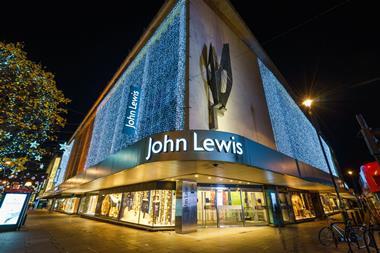When Hammerson signed John Lewis last week to anchor its Eastgate Quarter scheme in Leeds, it must have been a weight off the developer’s mind. To have secured the department store as a centre’s anchor is the closest you can get to guaranteeing other big-name retailers will follow suit. The evidence can be seen across the shopping centre market and on the high street too, with John Lewis’s recently refurbished Oxford Street flagship still drawing shoppers from far and wide and its new stores in Cambridge and Liverpool off to strong starts.
But while nobody can deny the department store giant’s immense pulling power, John Lewis is susceptible to the ravages of economic strife like everybody else, a fact backed up by falling sales figures in all but two of its stores in one recent week. Developers have to work hard to attract John Lewis and it costs big money. But will the retailer be such a draw in a downturn?
For other retailers, John Lewis’s presence can be something of a double-edged sword. In order for developers to fund the lucrative concessions they have to make to get the retailer to sign, they will invariably transfer the cost onto the rest of the centre’s retail tenants. As a result, retailers find themselves subsidising the biggest fish in the pond, which will often be hoovering up precious footfall – and spending – too. Harper Dennis Hobbs director David Harper explains: “The developer makes no money on a deal with John Lewis and the people who end up paying are the other retailers.”
Yet at the same time, the footfall lift that the department store’s presence triggers is priceless. And the added kudos it brings to a centre means that other retailers will snap a landlord’s hand off to get space. “Having John Lewis as an anchor bestows Premiership status on a shopping centre that might otherwise have been considered Championship quality,” admits Harper.
CBRE director David Kenningham agrees. “It’s a great brand to have,” he says. “It’s a true department store: it does everything a department store should do. Some department stores are glorified fashion houses. John Lewis does a proper range of kitchenware, beds, furniture, electronics and fashion, etc – this is one of its big attractions.”
John Lewis is a formidable retailer. With 26 stores across the UK in some of the country’s top shopping centres, it has a trust and universally admired reputation that no other department store matches. Since it was established in the 19th century, it has grown into a class operator selling an extensive range of high-quality goods.
This year, it opened stores in some of the most prestigious schemes to open, including Grosvenor’s Liverpool One and Cambridge’s Grand Arcade. And, on top of its existing portfolio, there are a number of pipeline schemes that John Lewis is preparing to anchor as it aims to double its number of stores. It will also anchor Hammerson’s Highcross Leicester, for example, which is due to open in September.
Hammerson has particularly close ties with the department store retailer and is open about the value of this relationship between the two. Managing director of UK retail David Atkins explains: “Our strategy on shopping centres has aligned well with John Lewis’s. In terms of what it offers, undoubtedly it is a big draw and it attracts other quality retailers. Not only does it draw in higher footfall, but it also draws on a deeper catchment that grows as a result of it being in a centre.”
Branching out
And there are more new offerings from John Lewis on the way. By the end of 2014, another 10 will have opened, with its launch at St David’s 2 in Cardiff next year – its first store in Wales – following this year’s Leicester opening. Among the future sites are Stratford in east London, Sheffield, Leeds, Oxford, Preston and Crawley. It is also preparing to make its debut in Northern Ireland, at the Sprucefield shopping centre outside Lisburn.
One centre that has benefited greatly from the retailer’s presence is the Bon Accord centre in Aberdeen. Owned jointly by Land Securities and British Land, the scheme boasts a 200,000 sq ft (18,500 sq m) John Lewis.
Richard Noble, director of Aberdeen agent FG Burnett, who acts for the joint Bon Accord partnership, says: “John Lewis is an anchor of choice for developers. The range of offer and quality of service is fantastic. We’re very lucky in Bon Accord to have John Lewis as an anchor, because it’s the only one north of the central belt.”
As well as its range and the unique tradition of service and quality that precedes it, the fact that many of the goods on offer at John Lewis are own-branded means that there is less crossover of brands with other retailers in a shopping centre than is the case with other department stores.
John Lewis values its strong partnerships with property developers. “We have built an enviable reputation among developers and investors for delivering full-range department stores of exceptional quality,” says head of retail development Jeremy Collins.
“The range of products, price commitment, and service proposition have been consistently praised by customers, and our continuing commitment to expansion and the long-term stability of our business make us a natural partner for major projects. The success of our new shops at Cambridge and Liverpool are testimony to the strength of our proposition.”
However, despite all of these attributes there are a few key drawbacks for retailers and developers to be aware of. Getting John Lewis on board isn’t cheap. The John Lewis Partnership is well aware of the strength of its brand and its allure to developers, and wisely makes the most of this. As a result, it comes to the table holding most of the cards and has therefore been able to dictate terms to an extent.
TOUGH NEGOTIATOR
JLP is a rigorous company that drives a hard bargain. A developer will usually have to fund a store fit-out, won’t be able to charge market rent and will often have to shoulder a considerable proportion of the marketing costs for its store. In addition, in lease negotiations John Lewis will insist on a capped service charge, often well below market value. On top of all this, a landlord would expect to have to pay a premium to guarantee that it signs, often in the millions. When Grosvenor signed John Lewis to anchor Liverpool One, it was reputed to have paid the retailer in the region of£2 million to secure the lease.
For developers, this has in the past been a cost that they have chosen to bear, because of the immense rewards to be had. However, as credit becomes scarcer, every cost is being scrutinised. Big anchor tenants like John Lewis, Marks & Spencer and Debenhams may find as time goes on that landlords cannot afford to be as accommodating. As Noble says: “Retailers need to realise that, while anchors are crucial, it perhaps needs to be more of a partnership.”
As a sobering reminder that John Lewis isn’t invulnerable to the effects of reduced spending, figures published last month revealed that sales had fallen from last year in all but two of its stores – Oxford Street and Bon Accord. While this is by no means a rarity in today’s retail market, it is one more sticking point that developers will bear in mind.
Looking at the pipeline over the next six years, there are those who argue that John Lewis is in danger of diluting this reputation by opening in weaker catchments. At these sites, there is a risk that retailers might get on board simply to follow John Lewis when the demand is not there.
You will struggle to find anyone in retail who will deny the power of this class department store retailer. It may not align perfectly with all retailers or developments, but its presence in a centre instantly makes it hot property.
But times are changing and developers will have to look more carefully at how much they spend on bringing John Lewis in.
“John Lewis provides a lot of quality, but equally there’s a lot of costs,” explains Atkins. “Now, in hard times, the whole equation of sustaining the cost of a John Lewis fit-out will have to be looked at. John Lewis understands the value of its brand, but like all of us, it is going to have to re-evaluate the way it does things.”
And will it be prepared to compromise? Harper thinks not. “John Lewis doesn’t do flexible,” he says. Yet, in such a stormy climate, all businesses will need to adapt to changing times.
The next 10 shopping centre stores
2008
Leicester
2009
Cardiff
2011
Stratford, Sheffield, Sprucefield
2012
Oxford, Leeds
2014
Portsmouth, Preston, Crawley


























No comments yet